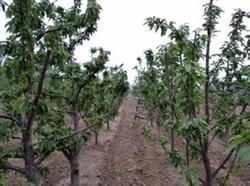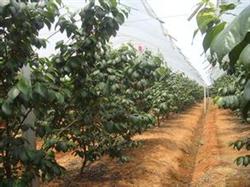Key techniques of Postharvest Management and Summer pruning of Cherry

In order to promote flower bud differentiation and prevent excessive vegetative growth, new shoot coring should be controlled. That is, to pick the coring of the new shoots that have not stopped growing, the position of the coring is generally bounded by the half-leaf; after the coring stops for 10-15 days, the second shoot will be sent out, and when it grows to 15-20 cm, the second coring will be carried out, and the position is still bounded by the half-leaf. After the cherry is harvested, the big branch with a small angle of the first-class branch can be pulled so that the angle between the cherry and the main branch is 70-80 degrees. It can improve the ventilation and light transmission of the tree, and ease the growth potential at the same time, which is very beneficial to the flower bud differentiation. Pay attention to the anti-injury pad at the binding point before pulling, so as to avoid pulling the cortex of the big branch. Too many big branches are pruned and the trees are closed, which is one of the important reasons for the weakness of cherry trees, the decrease of resistance and the occurrence of diseases and insect pests. Moreover, the younger the cherry branch is, the stronger the resistance is. A certain pruning of big branches can improve the overall stress resistance of cherry. At the same time, through pruning, too many flower buds are reduced to ensure a larger fruit in the coming year. To remove the big branches, we should grasp the following aspects: first, the pruning of the big branches should be carried out from the top to the bottom and should not be done in too much haste. The annual removal of large branches in summer is about 15% to 20% of the total, and it should be removed year by year according to the situation of the tree. it is generally appropriate to complete a round of pruning in 3-4 years. Keep the overall tree shape with sparse upper main branches and relatively dense lower main branches. Second, it should be carried out according to the length of the fruit branch. The longer the fruit branch is, the earlier it should be removed to promote the retraction of the fruit branch and the compact shape of the tree. Third, it should be selectively removed according to the growth of new shoots. If the growth of the new shoot is small, it should be removed first. The fourth is to remove the mastery of time. The removal of big branches can generally be carried out after harvest to mid-July, and in some cases, it can even be carried out during the fruit harvest period, such as cutting off the head in combination with cherry picking, sawing the overlong top branch with fruit, and picking fruit on the ground. In addition, sawing big branches should generally avoid periods of heavy rainfall to prevent glue flow. Note that when the big branches are removed, it is generally necessary to leave a certain length of branches at the pruning site to promote wound healing and prevent excessive retraction of fruit branches.
- Prev

Common diseases and insect pests of cherry and their control
Many diseases and insect pests of cherry are the same as those of other drupe fruit trees, which can be used for reference. The main diseases of cherry are perforation, root neck rot and visceral disease. Root neck rot often occurs on trees in the early fruit stage, causing root neck ulcers. Prevention and control methods: mainly to avoid long-term cultivation of soil in the root neck of the plant, prevention and control of underground damage.
- Next

Don't relax the postharvest management of cherries
First, pay attention to summer shears. While removing the film, it is necessary to retract the crown in time and carry out heavy strength pruning. 1. Retract the crown. This method can reduce the overall height of each cherry crown by 50 cm to 80 cm, preventing the tree from growing higher and higher, affecting the indoor ventilation and light transmission conditions. two。 Pruning and thinning the main branches. It needs to be cut again.
Related
- Moge, come on! The staff of the peasant association in the producing area of cantaloupe were frightened when the crowd gathered.
- Causes and Solutions of low Fruit setting rate of Apple
- Symptoms and control measures of passion fruit virus disease
- Fruit growing lesson: how do apple orchards keep high yields?
- Can you build orchards in the mountains? What are the pros and cons?
- How to manage the coloring period of Crisson grape?
- This paper introduces the processing technology of two kinds of fig products.
- How much is a month for retired teachers in rural areas by 2020?
- How can strawberry planting increase sugar content? We should pay attention to management in many aspects.
- What are the cultivation techniques on how to improve the yield of golden fruit?

